Oxford University Press's Blog, page 103
July 5, 2021
Adapting Shakespeare: shattering stereotypes of Asian women onstage and onscreen

In 1930, English novelist Evelyn Waugh entertained the prospect of Chinese-American actress Anna May Wong playing Ophelia, Hamlet’s love interest: “I should like to see Miss Wong playing Shakespeare. Why not a Chinese Ophelia? It seems to me that Miss Wong has exactly those attributes which one most requires of Shakespearean heroines.” Waugh went on to say that “I cannot see her as Lady Macbeth, but she seems to me perfectly suited for the role of Juliet or to any of the heroines of the comedies” (The Daily Mail 24 May 1930).
There has always been some perceived affinity between the submissive Ophelia and East Asian women. Ophelia is a paradox in world literature. Even when she appears to depend on others for her thoughts like her Western counterpart, the Ophelias in Asian adaptations adopt some rhetorical strategies to make themselves heard, balancing between eloquence and silence, shattering the stereotypes about docile Asian women.
Gender roles in Shakespeare’s plays take on new meanings when they are embodied by Asian actors. For instance, inspired by feminist voices, several South Korean adaptations of Hamlet recast Ophelia as a shaman who serves as a medium to console the dead and guide the living. Because female shamans exist outside the Confucian social structure, they have greater agency. In some instances, a shamanistic Ophelia figure frames the entire play.
In some productions, Ophelia appears as a ghost. Jo Kwang-hwa’s play, Ophelia: Sister, Come to My Bed (1995), opens with Ophelia’s funeral. Ophelia is caught between the incestuous love of Laertes and the romantic love of Hamlet. Eventually, she is abandoned by both men: Laertes has no future with her, and Hamlet must carry out his revenge mission. Possessed by the dead king’s spirit, Ophelia conveys the story of his murder and urges Hamlet to avenge his death. When the ghost of Old Hamlet appears in the form of a large puppet operated by three monks, Ophelia moves in unison with the ghost and changes her voice to that of an old man. The effect is unsettling.
In other instances, Ophelia has more moral agency. In Feng Xiaogang’s martial arts film The Banquet (2006) Qing Nü, unlike Shakespeare’s Ophelia, is able to express her thoughts without going mad or resorting to singing as her only form of communication. Qing Nü is not drowned in the end, although she is still associated closely with water. Her songs allude to rivers and boating, and her intimate scenes with Hamlet often involve rain. An example of the water symbolism is a scene in a rainy courtyard where Qing Nü washes the prince’s hair as the prince looks up at the falling rain drops. As a symbol of innocence in a court of violence and intrigue, Qing Nü occupies the moral high ground. Significantly for a martial arts film, Qing Nü is the only character who is not versed in swordsmanship. Qing Nü publicly expresses her love for the prince. Her passions are uncensored and her reason is simple: she wants to accompany the prince so he will not be lonely. Unlike Shakespeare’s Ophelia, Qing Nü does not have to go mad or speak allusively to express herself.
“Reflecting the idea that strength and empowerment can take many forms, these performances counter the racialized myths about Asian women”
Not all performances of Ophelia involve female empowerment. Some productions use her fate to highlight a history of oppression. Ophelia gives away some dolls in the Japanese director Yukio Ninagawa’s Hamlet (Barbican, London, May 2015). The production featured a gigantic, tiered hina-dolls display. Actors became human-sized dolls in the play-within-a-play scene. The set is inspired by the Japanese Girls’ Day or Dolls’ Day, a festival celebrating girls’ development and well wishes for their future. Since the dolls represent hope, Ophelia’s giving away dolls rather than flowers in her mad scene carried with it a grave tone, playing as a disruption to established rituals. Dolls adrift was a metaphor for Ophelia’s drowning and evoked the eleventh-century Genji-Monogatari. The floating-doll ritual is still performed by Kamigamo and Shimogamo Shrines in Kyoto. In some instances, the previous year’s dolls are brought to the shrines to be burned. Ophelia’s life-sized dolls drew attention to the artificiality of rituals and the performance.
Reflecting the idea that strength and empowerment can take many forms, these performances counter the racialized myths about Asian women that have led to the fetishization of Asian women as subservient and dainty objects. The fetish makes Asian women interchangeable. East Asian women are seen as erotic because they are perceived to be exotic in physique and manners. While her songs still occupy the center of attention, Ophelia does not tend to stand in for lost girlhood or female madness in East Asia. The strands of girl power and fragile girlhood coexist as Asian Ophelias lay claim to their moral agency by thinking and acting on their own behalf.
Feature image by Flybynight from Pixabay

July 4, 2021
Which law applies to negotiable instruments?

The three types of negotiable instruments governed by legislation are: bills of exchange, promissory notes, and cheques (bill, notes, and cheques). The bill is an unconditional, written, signed order in which one party instructs another (the drawee) to pay a specific sum of money to a third party. A cheque is a variant of the bill in which the drawee is a bank. A note is an unconditional written promise to pay money. Hence, negotiable instruments could be characterised as an unconditional obligation embodied in the form of a physical document. “Negotiability” is a central common feature of the three types of these instruments according to which the instrument holder may transfer it (and the right to payment under it) by physical delivery (possibly with an indorsement) to another party, who may acquire a better title than the transferor.
The law of negotiable instruments is known for its sophistication and internal complexity. For centuries it has provided an effective legal solution for the pertinent needs of domestic and international commerce, facilitating predictability, protection of parties’ justified expectations, and the elimination of the risk involved in the physical carriage of money. The internal balance of its rules, doctrines, concepts, and principles has been achieved through a slow and ongoing evolution—a Sisyphean effort of adjudication tribunals to balance of the interests of commercial actors, fairness, legal predictability, and commercial utility.
Significant parts of commerce continue to use negotiable instruments. Payment mechanisms will not disappear in the advancing reality of digitalization. All essential elements of negotiable instruments law—the requirements of writing, possession, and signature—could be functionally adjusted to this reality (see the Electronic Communications Convention and MLETR). Once this happens, a digital negotiable instrument would become a powerful competitor to credit cards and online methods of payment. After all, this law has the advantage of the accumulated wisdom of centuries, internal sophistication, and a self-reflective process of learning from its own mistakes and deficiencies. Thus, it lacks the deficiency of the online mode of payment under which the transfer of funds from one account to another takes place immediately—which is disadvantageous to consumers. The negotiability feature of this instrument could meet the demands of sophisticated contemporary financial structures and commercialization.
With the growth of cross-border commerce, there is a critical question of the applicable law to govern the various aspects of the parties’ rights and obligations under the instrument in an international setting. In legal jargon, the area of “conflict of laws” deals with this question. Despite some harmonization efforts, the legal systems have not reached a consensus with respect to key substantive aspects of negotiable instruments law. This diversity amongst the systems signifies the centrality of the conflict of laws analysis that may determine the outcome of litigation.
Unfortunately, a review of the relevant rules reveals a great concern. The conflict of laws rules concerning negotiable instruments diverge amongst the systems. Worse, these rules fail to reflect the essentials of negotiable instruments law and accommodate the developments that have taken place within the modern conflict of laws doctrine over the recent decades. Thus, the present rules adhere to an unhelpful stringent dichotomy between “foreign” and “domestic” instruments; follow the condemned arbitrary rule of the place of contract formation; and deny the most important principle of the modern conflict of laws thought—a principle that enables the litigating parties to determine the identity of the applicable law.
The reason for this troubling situation lies in the complex nature of negotiable instruments. Well-known in the conflict of laws literature, the Giuliano & Lagarde Report has served as a basis for contemporary European Rome I Regulation, which characterised this area of law as “complex” and “unique.” The US Second Restatement uses similar language to justify the exclusion of negotiable instruments from ordinary conflict of laws analysis. This “uniqueness” thesis explains why the conflict of laws rules relating to negotiable instruments have been left behind in the development of the modern conflict of laws doctrine.
However, one can challenge the “uniqueness” thesis. A careful assessment of negotiable instruments law suggests that the precise demarcation of its special nature is a sophisticated reflection of the traditional contract law and property law categories. This argument rejects the alternative vision of the subject as a reflection of the mythical “law of merchant”. Negotiable instruments law epitomises the complicated rules of traditional contract law and property doctrines; its foundations remain very much based on these doctrines, with relevant modifications. Accordingly, one would call for a reconsideration of the current position which leaves negotiable instruments law outside of the modern developments within the conflict of laws rules applicable to contract and property.
Sadly, after thorough analysis under the principal global legal systems, we have concluded that the contemporary conflict of laws rules within negotiable instruments law have originated from flawed premises about the nature of the subject. Further, contemporary rules have left behind the modern development of conflict of laws doctrine. The call for a “radical overhaul” of the rules echoes those concerns. Relying on the foundation of negotiable instruments’ law within the traditional ordinary doctrines of contract and movable property and invoking developments within modern choice-of-law thought, legal scholarship must endeavour to comprehensively challenge the traditional orthodoxy and offer a complete re-examination of the conflict of laws rules concerning negotiable instruments.
Featured image by Free-Photos via Pixabay.

July 3, 2021
Whose streets? The picturesque, Central Park, and the spaces of American democracy
 Dedicated to Alice Lipton (1/30/1930-6/20/2021), who loved Central Park
Dedicated to Alice Lipton (1/30/1930-6/20/2021), who loved Central ParkLast summer, during the “Black Lives Matter” protests in US cities which were galvanized by the murder of George Floyd, it was common to hear marchers chanting: “Whose streets? Our streets!” In some instances, police seeking to break up the protests also took up this chant, an ironic retort to the crowd’s claim to political power. These contesting claims to possession of the city streets framed a conflict over social representation in contemporary US life: “whose streets” are they really?
The picturesque might not be the first context that comes to mind when we think of social conflict on US city streets. For most, the picturesque probably evokes pretty scenery in the countryside somewhere far from the city. But for mid-nineteenth century Americans it often had a political element, reflecting many of the social concerns of a new American urban bourgeoisie. Writings about the picturesque helped to create new conceptions of rural and urban spaces and some in-between spaces, like scenic tourism sites and the suburbs, that have come to define our landscape. These picturesque spaces were negotiating many of the social conflicts of the time.
Another prominent picturesque space developed in this period was the public urban park. The picturesque public urban park was a creation of bourgeois Americans who sought to address problems in the increasingly crowded, socially diverse, and contentious cities of the mid-nineteenth century. From 1825 to 1850 the urban population in the US tripled. Immigrants from Europe came in record numbers, settling primarily in northern cities, especially New York, swelling the ranks of urban poor and changing the social balance of American life. The sheer numbers of people, the increased diversity of the population, and the evident economic and social differences brought with it class conflict. In response, some proposed that bringing the peaceful countryside into the city in the form of landscaped public urban parks offered the possibility of ending conflict and creating a new social order.
The most influential advocate of the picturesque in mid-nineteenth-century US was Andrew Jackson Downing (1815-1852), a landscape architect and writer who radically changed how Americans saw and designed their lived spaces. Drawing attention to the beneficial social effects of public parks in European cities and their contrasting absence in his home country, Downing advocated for a “New-York Park” and claimed public parks could address the problem of social conflict: “With large professions of equality, I find my countrymen more and more inclined to raise up barriers of class, wealth, and fashion…and we owe it to ourselves and our republican professions to set about establishing a larger and more fraternal spirit in our social life.” Downing’s “New-York Park” was not commissioned as “Central Park” until after his untimely death in 1853, but still showed his influence: the design selected for the park in 1857 was created by Downing’s former partner, Calvert Vaux, and one of his acolytes, Frederick Law Olmsted (1822-1903), who would go on to become the most famous American landscape designer.
In his writings about the designs for Central Park, Olmsted explicitly framed the park’s meaning through the picturesque’s self-conscious aesthetics of viewing: “A park is a work of art, designed to produce certain effects upon the mind of men.” But Olmsted later admitted the primary concern of his earliest designs was not aesthetics, but social conflict: “The difficulty of preventing ruffianism and disorder in a park to be frequented indiscriminately by such a population as that of New York, was from the first regarded as the greatest of all those which the commission had to meet.” This concern was not his alone: contemporary detractors to the idea of Central Park feared that it would be merely another place—like that of the city streets—where social conflict would occur. In his discussion of this issue, Olmsted quoted an 1857 article from the New York Herald:
It is all folly to expect in this country to have parks like those in aristocratic countries. When we open a public park Sam will air himself in it. …He will knock down any better dressed man who remonstrates with him. …Now we ask what chance have William B. Astor and Edward Everett against this fellow-citizen of theirs? Can they and he enjoy the same place? Is it not obvious that he will turn them out, and that the great Central Park will be nothing but a great beer-garden for the lowest denizens of the city, of which we shall yet pray litanies to be delivered?
Astor and Everett were well-known members of the “the upper ten,” New York’s wealthy uptown mercantile elite, and “Sam” was a characteristic name for a Bowery B’hoy, a stereotypical figure for downtown New York’s working-class young men who had achieved no small degree of power in city life, both politically through their support of Tammany Hall’s Democratic political machine and socially through their aggressive presence on the streets. To the question “whose streets?,” bourgeois New Yorkers in the mid-nineteenth century felt that the answer was “not ours,” and the picturesque Central Park was designed to help reclaim them.
Advocates of Central Park sought to reclaim the city through what was called “popular refinement.” Downing defined popular refinement in his park writings: “The higher social and artistic elements of every man’s nature lie dormant within him, and every laborer is a possible gentleman, not by the possession of money or fine clothes—but through the refining influence of intellectual and moral culture.” Downing believed that exposure to refining cultural influences though public institutions like the park could transform the masses: “Let us take up popular refinement…and we shall see what a virtuous and educated republic can really become.” Olmsted embraced this notion of the public park as a symbolic vehicle for social transformation and social cohesion and would tout the success of Central Park and his later Brooklyn Park as realizations of Downing’s dream:
Consider that the New York Park and the Brooklyn Park are the only places in those associated cities where …you will find a body of Christians coming together, and with an evident glee in the prospect of coming together, all classes largely represented, with a common purpose, not at all intellectual, competitive with none, disposing to jealousy and spiritual or intellectual pride toward none, each individual adding by his mere presence to the pleasure of all others, all helping to the greater happiness of each. You may thus often see vast numbers of persons brought closely together, poor and rich, young and old, Jew and Gentile.
The reality was, of course, more complicated than Olmsted made it seem. The construction of Central Park brought with it economic and racial injustice, including the use of eminent domain to raze poorer communities on the land, including Seneca Village, a community of predominantly African-American small property owners. And despite Olmsted’s vision of a cohesive park community of “rich and poor,” it was patently obvious to contemporary working-class New Yorkers that the project of popular refinement was aimed at making them conform to bourgeois norms they consistently resisted. Poorer New Yorkers fought to add utilitarian and populist spaces like sports playing fields to the more picturesque elements—including a sheep-fold—that Olmsted initially designed for Central Park.
The history of the park has been a continual negotiation between the various different urban constituencies and their appropriations of park space. Despite this, in their The Park and the People: A History of Central Park (1992), Roy Rosenzweig and Elizabeth Blackmar conclude that “Central Park is still ‘the most democratic space’ in New York, if not in the United States.” As democratic US space, Central Park reveals both the important role that the picturesque played in the creation of a modern American landscape, and also the continual process of social negotiation that has shaped that landscape. Like the negotiations of Central Park, last summer’s “Black Lives Matter” protests are another example of the ongoing struggle to enact American democracy that has taken place in the spaces of American life.
Feature image: “Central Park (Summer)” (1865)—John Bachmann, CC0, via Wikimedia Commons

Listening as a way to manage stage fright

It is as important for music teachers to listen to what music students and performers say as to the music they play. The incident I am about to describe further opened my eyes and ears.
I always was interested in how to get help for my performance anxiety which, unfortunately, was not available when I was a music student at Juilliard. No one talked about it. It was too shameful to admit you were nervous, and typical advice was to practice more, believe in yourself, and/or don’t worry.
I taught piano for many years and performed professionally after my Juilliard graduation. I also struggled with stage fright since my first memory slip occurred at six years old. I loved performing but the emotional cost was steep. After a cancelled two piano performance with my husband due to a historic blizzard in Northern Michigan, and while sitting around reading magazines to pass time as roads were cleared, I found an article about a professor of psychology at the University of Michigan who was conducting research in test anxiety. Upon returning home, I called him and asked if we could discuss musicians and stage fright. I assumed there were similarities and treatments for stage fright and test taking.
He was happy to meet with me and invited me to help in his lab that was conducting an experiment on test anxiety. After some training, I was assigned an anxious Subject who agreed to participate in the data collection. The protocol consisted of using progressive relaxation, cognitive copying (i.e., relabeling negative statements into positive self-talk), and biofeedback.
“I realized vividly that I could not assume what a person needed. It was more important to find out what the other person thought to understand their account of what in their past created anxiety that may be manifest in performance fears.”
After linking biofeedback sensors to my Subject’s finger tips (warmer fingers would indicate lower anxiety), we began the full protocol. Her level of anxiety did not become lower over time although she agreeably complied with my instructions. When we reached the part where I had been instructed to use an image of relaxing on a beach, wind gently blowing, waves lapping, sun warmly shining to help her relax, I noted that the biofeedback indicator was rising rapidly. She was becoming increasingly anxious. This was neither the hypothesis predicted, nor did it feel comfortable for me to watch her anxiety climb toward a panic level. While knowing that altering the protocol would interfere with data collection, I made the decision to pause and talk with her. I did not follow instructions! Commenting on her high level of anxiety, I inquired about what was going on in her mind. She looked at me and forcefully told me, “I HATE beaches.”
If there was a defining moment that contributed to my return to a graduate program to broaden my interest in stage fright and to gain a psychological and psychoanalytic perspective, it was this one. More importantly, I realized vividly that I could not assume what a person needed or advise them what to think or what to do. It was more important to find out what the other person thought, to inquire, to ask questions, to hear what they liked and did not like, and to understand better their account of what in their past created anxiety that may be manifest in performance fears. In short, to LISTEN and to let the other person—or patient, student, test taker, doctor, executive, musician—talk. My professional role was to help that person feel understood and to use “theory” to address them as it applied to their experience of anxiety rather than a predetermined script.
I present various styles and theories of psychological management for anxiety and do not take a stance on which one is right for each person. There is no “one size fits all”—there is no “beach.” Rather, I try to inform performers and their teachers (when I have the opportunity) about options with pros and cons evenly presented and discussed. I found for myself, after gaining experience, that my own personal and evolving clinical orientation felt more comfortable working in a style that promotes self-exploration, self-discovery, and increases self-esteem. I ask questions, inquire about details, invite clarifications, and gradually my patients and I create a new way of thinking about old debilitating problems. I am also aware that patients perform in treatment as outside it to try to be agreeable, as did my Subject, or to look smart, or not to reveal their perceived flaws. We examine this performance before our eyes and ears when together in session. It really helps!
“While realizing that teaching music is inherently more didactic than therapy, I maintain that listening to more than the music is an important tool for a teacher’s and performer’s mental toolbox.”
I also ask myself questions about what is resonating in my mind with the awareness I do not want to suggest that what is “right” for me is “right” for another person. This listening “technique” helps me become a better and more empathetic helper. While realizing that teaching music is inherently more didactic than therapy, I maintain that listening to more than the music is an important tool for a teacher’s and performer’s mental toolbox. It is a skill that can be used appropriately in the teaching studio and taken on stage internally by performers.
Some of my performance anxious patients know of my musical background (everyone reads the web now). Some do not or avoid letting themselves know about me (which is something we talk about either way). I have had some people tell me that they want me to tell them what to do because I know what it is like to be anxious and perform. Others are afraid I will tell them what to do and not help them to figure out what is bothering them.
Music teachers teach a whole person who brings a lifetime of experiences and feelings—a unique life history—to lessons. Of course, music teachers give specific didactic instructions and should not try to be therapists. They, too, bring their personal histories to their studios, of which they also need to be aware. Sensitivity to what the students say and how the teacher responds influences both the relationship and the way this instruction is perceived, internalized by the student, and carried onto the stage. Music teachers (all teachers) can join their students in co-creating the best possible environment psychologically and pedagogically for learning and enhancing self-confidence. It is these attributes that can provide internal confidence that helps individuals better manage stage fright.
Feature image by Oscar Keys via Unsplash

July 2, 2021
Marie Madeleine: exploring language, style, and humour in the Acadian folksong tradition

There are two main French speaking groups in Canada: the Québécois and the lesser-known Acadians, who have a fascinating but tragic history in Canada. After failing to establish a post on St Croix Island (present-day Maine) in 1604, the Acadians became the first French colonial group to settle on Canadian soil in 1605 (in present-day Nova Scotia), three years prior to the arrival of the Québécois. When the British took control in 1713, Acadian colonizers suddenly became the colonized, and found themselves in a precarious political situation. Asked to pledge allegiance to the British Crown, the Acadians refused, preferring to remain neutral. Unfortunately, the British believed they might still side with the French, and began to deport them in small groups to various places starting in 1755. One such place was Louisiana where the term Acadiens—because of how non-French speakers understood the word to be pronounced—became known as Cajuns. This colonial history—filled with family separation, death, and economic loss—continues to shape the Acadian story to this day.
After seven years of exile, some Acadians returned to Canada but had to live spread out over four different provincial territories. Unlike the Québécois, who have been able to develop a sense of national identity because they inhabit a common provincial territory, the Acadians had to rely on language to unify them. Folk song is not only emblematic of this language-based sense of nationalism but is a site in which to remember an idealized place called Acadie where Acadians experienced better times. Today, Acadie is understood to be a nation by those who inhabit it, despite its lack of geopolitical borders. Folk song—with references to place names, cultural traditions, and the old patois (dialect)—serves as a cultural identifier that connects this community (often called Acadians of the Maritimes) through time and space.
My father was Acadian and faced tremendous social disadvantage. Born to devout Catholic parents, he was one of ten children. Though he was the sole child to learn to read and write, he only completed grade eight before being sent up north to fish and trap with his brothers. He also encountered a lot of discrimination as an Acadian speaker. For instance, due to language stratification among French speakers, he was told by a nun from Quebec to stop speaking French at home because he spoke a “low-class” form of French. Because he lived in an Anglo-dominant society he—like many linguistic minorities in the twentieth century—had difficulty finding work until he lost all trace of his French accent. This of course resulted in a deep sense of cultural inferiority, something felt by most Acadians in his age group.
While folk song was and is part of Acadian social life, the Catholic Church also employed folk song as a social tool in Catholic educational institutions inside Acadia during the first half of the twentieth century. Aiming to develop a sense of Acadian national pride, the clergy promoted upbeat tunes to encourage the Acadians to move beyond the past to a more promising future. During the 1960s and 1970s, Acadian folk song was also used as a political tool to fight for French language rights in Canada’s Maritime provinces, while in more recent years folk song helps shape the Acadians unique identity in the wider Canadian mosaic.
Marie Madeleine or “Une petite vache noire” is a well-known folk song in French Canada. It is a lively, humoristic piece that provides an excellent example not only of the percussive style of the Acadian language, but of the characteristic stylistic elements of the Acadian folk song tradition: podorythmie (seated foot-tapping), diddlage (mouth music), and the spoons. Never a group to take themselves too seriously, this song harkens back to the Acadians’ agrarian past and tells the story of Marie Madeleine who, while ill-advisedly dressed in a pretty skirt and petticoat, encounters a rather mischievous black cow who ends up throwing her into a pile of manure.
Watch the video below to find out more about my arrangement of Marie Madeleine:
Featured image by Camila Damasio via Unsplash

July 1, 2021
What does it mean to think of the world “in Jewish”?
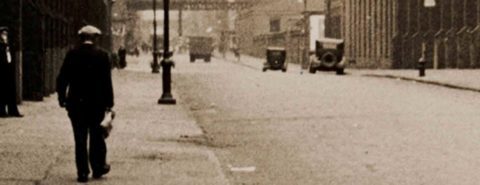
Antisemitism has been increasingly in the headlines, from reports of violent incidents directly targeting Jews to the growing prominence of ethnonationalist discourse that makes frequent use of Jewish stereotypes. This surge in anti-Jewishness includes renewed attention to the medieval image of the wandering Jew, translated into contemporary parlance with the term “globalism.” Conservative activists see the interconnected globe as a threat to traditional social structures, and as directly linked to diasporic Jewish thought, politics, and culture. For these conspiratorial thinkers and their political representatives (from Viktor Orban to Donald Trump and beyond), Jewish worldliness serves as a menacing foil to the violent reactionary politics of contemporary nationalism.
It would be tempting to dismiss such ideas as uninformed distortions of Jewish culture and history. One could point to examples of Jewish patriotism or to various forms of Jewish nationalism that even share a disdain for “globalism.” Indeed, many argue that Jewish communal life is unfairly targeted and that Jews belong to a minority group not much different from any other. However, these defenses are often articulated by those who would simultaneously emphasize the unique suffering of the Jewish people throughout global history and tout the particular achievements of Jewish genius. This can easily devolve into something of parlor game of counting good Jews and bad Jews, good global citizens and bad globalists. The refutation of stereotypes often serves to strengthen them: these particular Jews are “normal,” but the seemingly timeless idea of the Jew remains steadfast.
It may be useful then to think with the stereotype rather than against it. What does it mean to think of the world “in Jewish”? What might a vocabulary of Jewish worldliness reveal about the global present?
“What might a vocabulary of Jewish worldliness reveal about the global present?”
An exercise in translation might be helpful here. The word “world” comes from the German Welt, which combines the Latin vir with the Germanic alt to mean “the age of humanity.” Over time, this temporal designation gave way to a spatial one, as Welt came to refer to the space in which humanity exists. Welt thus produces a confluence of time and space, marking the capacity to measure history and memory within a knowable realm of human existence. So something like “world literature” would indicate the attempt to conceive of all of literature, across languages and across space and time, within a system of cultural exchange.
The translation of “world” into Hebrew produces a similar confluence, though with a more explicitly redemptive horizon of meaning. The Hebrew for “world,” olam, as found in the Bible, rarely if ever actually means the physical world. It initially denotes the long duration of existence, both human and divine, transcendent and mundane, future and past. The phrase brit olam means a divine covenant for all time; metey olam refers to those that have been long dead. The term only takes on the more widely known (and more modern) meaning of the physical world in post-biblical literature where there remains an uneasy convergence between the concrete and the spiritual: to live in this world, ba’olam haze, in a profane world of experience, and to strive to gain entrance into the messianic world-to-come, olam haba, the world of eternal transcendence. Thus, in Jewish tradition, from biblical to rabbinic sources, a person exists under the demands of opposing yet complementary “worlds”: human and divine, transient and eternal, circumscribed and boundless. A Hebrew world always reaches toward a messianic horizon. To return to the world literature example, a literature of olam would be one marked by eternal and redemptive aspirations. This ends up being a rather familiar definition of world literature, indicating those texts judged to have accessed some universal standing, above and beyond any specific cultural origin.
Something else happens though when we turn to a different Jewish vocabulary: what does it mean to think of the world in Yiddish, the 1000-year-old vernacular of Eastern European Jewry? Yiddish is a fusion language, its Germanic shell incorporating vocabularies and grammatical structures from Hebrew and Aramaic, along with Romance languages, Slavic languages, internationalisms, and other languages. The German Welt is perfectly at home in Yiddish as velt. As a result of Yiddish’s multiple language components, a given concept may be covered by several words, in particular the doubling of a Germanic word with a Hebraic one. Thus, Yiddish has olam in addition to velt. As is common in such borrowings, a third horizon of meaning appears in the gap between the languages. In Yiddish, olam, pronounced in an Ashkenazi accent as oylem, retains all of its Hebrew meanings but also enjoys a supplementary one—audience or crowd. In Yiddish, designations of time and place, sacred and profane, this world and the next world, are constrained by the immediacy of an oylem.
“When we translate “world” into Hebrew and Yiddish we realize that there is a constant struggle to determine in what worlds and in whose worlds a text belongs and how various worlds interrelate and overlap, if at all.”
In this translation, many of the metaphysical and theological significations of the world become secondary. Oylem limits our understanding of the world to that which is determined by concrete human activity. Oylem literature isn’t some universal group of texts, but rather that which is determined by the shifting needs of actual readers. Simultaneous to the world’s proposed status as a system of exchange or a mode of transcendence, there persists underneath a world of human judgment and institutional action: a set of people in a room deciding whether to clap or not.
Taking these translations together, Jewish worldliness does not necessarily connote a nefarious plot to control the global economy, nor does it require messianic longing for a borderless utopia. Certainly, these meanings persist—but they also run up against a vernacular remainder. When we translate “world” into Hebrew and Yiddish we realize that there is a constant struggle to determine in what worlds and in whose worlds a text belongs and how various worlds interrelate and overlap, if at all. Thinking of the world as oylem introduces a translational limit: the promise of a single organizing structure—the cohesive map of the world’s cultures, the conspiracy theory that explains everything—must encounter concrete empires of culture and all that is untranslatable about human community. Oylem allows us to imagine the possibility of planetary human connection while acknowledging the challenge and vitality of difference.
Featured image from the cover of Jewish American Writing and World Literature: Maybe to Millions, Maybe to Nobody by Saul Noam Zaritt.

June 30, 2021
On tokens, beacons, and finger-pointing

People have always tried to foresee the events that might occur in the days to come. This attitude did not depend on whether they believed that the future was behind or ahead of them (I am saying it in allusion to my post “The Future in the Past”). Obviously, the English verb foresee presupposes that in our (modern, Western) view, the future is before us. To penetrate the darkness separating today from tomorrow, our ancestors used all kinds of omens and, in thinking and speaking about them, usually distinguished between good and bad augury. In the Germanic languages, two words are particularly relevant to our topic: token and beacon. Beacon may sound unexpected in this context. Therefore, it will be more practical to begin with token.
Token is a Common Germanic word. The forms are Old English tāc(e)n, Old High German zeihhan, etc. The English noun combined the senses “sign, signal” and “portent, marvel, wonder.” German Zeichen and Dutch teeken are still alive but mean only “indication, sign.” Old Icelandic had teikn (its cognates exist in all the modern Scandinavian languages) and then borrowed the related similar-sounding form from Old English: Old Icelandic tákn meant “wonder.”
Gothic, a Germanic language recorded in the fourth century (part of the New Testament in this language is extant), also seems to have had two nearly identical forms: taikn “token” and taikns for “token” and “miracle” (but the occurrences are so few that there is no certainty that we are really dealing with two words). The Gothic Bible was translated from Greek, and the two Greek words that Bishop Wulfila, the translator of the text, saw were ‘éndeigma and sēmeîōn. The word occurs in 2Th, 1.5. In the Authorized Version, this place in the epistle sounds so: “Which is a manifest token of the righteous judgment.” The Gothic verbs with this root meant “to show, manifest; exhibit; revelation” and—the most interesting gloss to us— “teach.” In the oldest period, English teach also meant “to show.” Teach and token are indeed related words: the root of both was taik– “to show” (one teaches, instructs by showing). A series of regular phonetic changes resulted in that the sounds in the modern forms token and teach look so different.
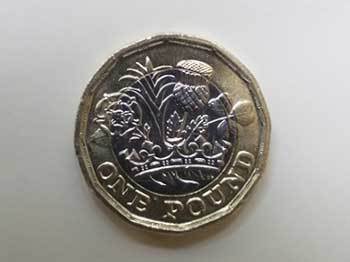 A vulgar token: no mystery at all. (Image via Wikimedia Commons, )
A vulgar token: no mystery at all. (Image via Wikimedia Commons, )The Indo-European etymology of token poses no problems. Everywhere, as in Germanic, the root of this word meant “to show,” and the story might have ended here but for the existence of the Gothic verb tēkan “to touch.” By ablaut (that is, by regular vowel alternation) it is related not to token but to Old Iceland taka, which was borrowed into Middle English and became Modern English take. Unexpectedly, the origin of take and of its Gothic cognate tēkan is all but unknown. The Greek form Wulfila translated as tēkan was ‘aptesthai “touch”; the prefixed form at-tēkan also meant “touch.” Note this gloss!
Now, touch came to English from Middle French. Its Romance source sounded toccare or tuccare. It did not continue any Latin verb and must therefore have been a “popular” innovation. In the modern Romance languages, this verb often means not only “to touch” but also “to strike.” Since it has no Latin source, its origin poses problems, and several hypotheses have been advanced to explain it. Finally, Romance scholars agreed that the mysterious verb was onomatopoeic, from toc (toc-toc), that is, from the sound we hear when we knock on (or touch!) wood, literally or figuratively. The figurative meaning will soon come us in good stead. “Knock,” “strike,” and “stroke of a bell” are among the most common senses of the modern cognates of this verb in Romance. (In Russian, the imitation of the sound for knocking on the door is tuk-tuk, with u as in English put. Likewise, stuk means “knocking”; s- is a prefix).
English tuck “to pull” is usually explained as a borrowing from Continental Germanic (the related German and Dutch verbs mean almost the same), because it surfaced only in the Middle period, but Henry Cecil Wyld, in The Universal English Dictionary, pointed to Old English tucian “to disturb; torment; punish” as the verb’s possible source, and he was not alone in thinking so. Even though his hypothesis is at odds with chronology, the reference to tucian (a verb of unknown origin!) need not be disregarded. We seem to be dealing with a group of tuk-tok verbs that at one time designated knocking, striking, and touching.
 Doubting Thomas. (Image by Hendrik ter Brugghen via Flickr, CC BY-NC-SA 2.0)
Doubting Thomas. (Image by Hendrik ter Brugghen via Flickr, CC BY-NC-SA 2.0)English tug “to pull with force,” most likely from Scandinavian, is a synonym of tow. Both verbs are related to Modern German zucken “to pull” and to Latin dūcere “to lead.” The senses “lead” or “drive” are not too remote from “pull” and “push.” And here we can return to touch. Wyld believed that the Romance toccare had been borrowed from Germanic. Considering how widespread the use of the tok– ~ tuk– root is, it is hard to choose between a borrowing and parallel development.
At this stage, one expects a solution, but we have only amassed a group of words vaguely referring to sound imitation, touching, pulling, and the like. No solution would perhaps even have presented itself if in their discussion of Gothic taikn and tēkan so many good researchers had not mentioned, almost apologetically, Latin digitus “finger,” another word of undiscovered origin. No one knows what to do with it, but I suspect that it conceals a clue to our riddle. Perhaps digitus has the same expressive root as the words discussed above, and I would like to suggest that the semantic core of all of them was the concept of “finger.” (By the way, I once devoted two essays to the etymologically obscure English word finger: see the posts for 25 September and 2 October 2019.) People knocked, pointed to things, taught, and knocked on wood or touched wood with a finger for the purpose of divination. This may be the reason the word for token (that is, “mark, sign”), a thing touched, was used with such consistency in magico-religious sense. The Germanic noun made its way into Finnish; taika means “divination, portent.”
 Hoping for good augury. (Image by Pete Souza, via Wikimedia Commons)
Hoping for good augury. (Image by Pete Souza, via Wikimedia Commons)The relevant Germanic and Romance verbs began with a t. If the Romance borrowed toccare ~ tuccare from Germanic, then we are limited to this one branch of Indo-European. In Latin and Greek, the same root possibly began with a d. Latin digitus and Greek dáctulos “finger,” I propose, may belong here too. If all those words were related in a regular way, then the d ~ t correspondence would be natural, but the names chosen for the finger and the token (such as Gothic taikn or taikns) need not have been related to digitus. Long ago, I devoted a post to the English verb dig and concluded that this obscure verb was expressive and referred to the effort accompanying the process of digging. It appears that the t-k and d-g sound complexes were natural candidates for coining such words. As time went on, the root t-k “grew flesh,” and short and long vowels appeared between the consonants. In Germanic, the Indo-European word for “finger,” if it existed, was replaced with an innovation (finger is a Common Germanic noun), and that is why its origin remains a matter of guesswork. The history of token and its illegitimate Gothic brother tēkan “to touch” may have begun with pointing and the word for “finger,” the arch-pointer.
The main characters in our drama have been token (teach), touch, tuck-tug-tow (not to be confused with tic toc toe), and (a cameo appearance) digitus. Beacon was also promised in the title of this post. It will take center stage next week.
Featured image by Womanizer WOW Tech on Unsplash

Mexican independence from Spain and the first Mexican emperor
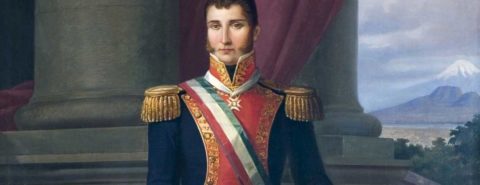
Mexico had been battling its way towards independence from Spain for some years when, in 1820, the Mexican-born officer, Agustín de Iturbide y Arámburu (1783-1824), proclaimed a new rebellion on behalf of what he called the Plan of Iguala. This called for Mexican independence, a constitutional monarchy with the Spanish king or another member of the Bourbon dynasty at its head, the Catholic religion as the only religion of Mexico, and the unity of all inhabitants, no matter what their origin, ethnicity, or social class. These articles were later boiled down to the so-called Three Guarantees: independence, religion, and unity (or union). It was decided that a provisional council would rule with a regency and that a new army led by Iturbide, called the Army of the Three Guarantees, would implement the provisions of Iguala.
When Spain’s representative, Juan O’Donojú y O’Ryan (1762-1821), arrived, he had no choice but to sign the Treaty of Córdoba on 24 August 1821, confirming Mexican independence. On 27 September 1821, Iturbide entered Mexico City. On the following day, amid general euphoria, the Act of Independence was signed and the Provisional Governing Council and the Regency were inaugurated. Iturbide was made president of the Regency and acted in this capacity from September 1821 until May 1822. He was repeatedly offered the throne in the autumn of 1821 and the spring of 1822, but he refused. He finally acquiesced in May 1822, when troops arrived outside his residence in Mexico City and demanded that he accept.
Agustín’s empire supposedly re-created the legitimate Aztec empire of Anáhuac, but when he was crowned and anointed on 21 July 1822 as Agustín I, many elements were borrowed from Napoleon’s coronation. The red fringed cloak he wore at his coronation was embroidered with eagles, for instance, and with the letters A and I. At the coronation, Agustín and his wife Ana Huarte were met at the door of the cathedral by two bishops and, as in Notre Dame in 1804, processed up the aisle under a baldachin. Three generals bore the crown, ring, and mantle of the empress and four the crown, sceptre, ring, and mantle of the emperor. The insignia were placed on the altar and two pairs of thrones for the emperor and empress were set up in the cathedral—smaller ones for before the coronation and larger ones for afterwards, again a Napoleonic arrangement. The religious ritual and the prayers were taken from the Pontificale Romanum, the official book of ceremonial of the Roman Catholic church, with some prayers taken from Napoleon’s coronation. Agustín and his wife were anointed on their lower right arms, Agustín swore an oath to uphold the agreement made with Congress on 21 May and was crowned by the President of the Congress. He then crowned his wife, as Napoleon had done.
Agustín’s reign was marked by frequent lavish public festivals, but they could not save him, and the manner in which he projected his power as emperor and his inability to satisfy conflicting demands led to widespread dissatisfaction. His overspending was much criticised, for his court consisted of 134 persons and his expenditure was reckoned to be five times that of the former Spanish viceroy. One and a half million pesos were allotted to the imperial house in the budget announced in December 1822. At the same time, because there was no money in the treasury, the army and government officials were forced to take a pay cut of up to 20% and there was a property tax of 40%. Large amounts of paper money were printed, and officials were forced to accept a third of their salaries in this useless currency. Criticism was freely voiced in the press, which led to attempts to curtail its freedom, and military tribunals were introduced. At the same time, crime rose. Agustín dissolved Congress on 31 October 1822, replacing it with a junta, thereby breaking the oath he had sworn at his coronation. After a series of uprisings against him in which he lost control of the army and the country began to fracture into separate provinces, he abdicated on 19 March 1823. He went into exile in Livorno in the Grand Duchy of Tuscany, but returned to Mexico on 14 July 1824, not realising that he had been outlawed in his absence. He was captured and executed by firing squad on 19 June 1824. His rule had lasted for only eighteen months in total, ten of them as emperor.
Featured image: Agustin I of Mexico, by Primitivo Miranda (1822-1897) – Ruiz~commonswiki, Public Domain, via Wikimedia Commons

June 29, 2021
How does ocean health impact life and livelihoods? [podcast]

June is National Ocean Month in the United States, and earlier this month, the whole world observed World Oceans Day, a day that has been celebrated since 2008 with a different theme each year. The theme for 2021 was “Life and Livelihoods.”
Covering 71% of the earth’s surface, the ocean is home to a vast array of life—an estimated 2.2 million species—and provides livelihoods for 40 million people in the fishing industry. But many scientists warn that the health of our oceans is in decline, threatening these species and the humans who depend on them.
The threats to our oceans’ health are multifold, and include deep-sea mining, offshore drilling, and ocean acidification. On today’s episode of The Oxford Comment, we are joined by biological oceanographer Lisa Levin of the Scripps Institution of Oceanography and contributor to Natural Capital and Exploitation of the Deep Ocean, and Ray Hilborn, a professor at the University of Washington and co-author of Ocean Recovery: A Sustainable Future for Global Fisheries? We tapped into their expertise to better understand the threats posed by overfishing, climate change, and biodiversity loss.
Check out Episode 62 of The Oxford Comment and subscribe to The Oxford Comment podcast through your favourite podcast app to listen to the latest insights from our expert authors.
Oxford Academic (OUP) · Ocean Health: Life and Livelihoods – Episode 62 – The Oxford CommentRecommended readingExplore our selection of books on ocean health and read free chapters by our podcast contributors.
Natural Capital and Exploitation of the Deep Ocean edited by Maria Baker, Eva Ramirez-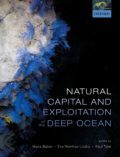 Llodra, and Paul Tyler
Llodra, and Paul TylerThe deep ocean is the planet’s largest biome and holds a wealth of potential natural assets. This book gives a comprehensive account of its geological and physical processes, ecology and biology, exploitation, management, and conservation. You can read the introduction, here.
Ocean Recovery: A sustainable future for global fisheries? by Ray Hilborn and Ulrike HilbornThe book provides a clear, engaging, and scientifically based description of the major controversies and contentions surrounding the world’s fisheries. Read a free chapter on “The Environmental Impacts of Fishing,” here.
Overfishing: What Everyone Needs to Know® by Ray Hilborn and Ulrike Hilborn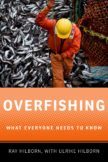
This title provides a balanced explanation of the broad issues associated with overfishing. Guiding readers through the scientific, political, economic, and ethical issues associated with harvesting fish from the ocean, it will provide answers to questions about which fisheries are sustainably managed and which are not.
Ecology of Coastal Marine Sediments: Form, Function, and Change in the Anthropocene by Simon Thrush, Judi Hewitt, Conrad Pilditch, and Alf NorkkoThis accessible textbook provides an ideal point of entry into the field, providing basic information on the nature of soft-sediment ecosystems, examples of how and why we research them, the new questions these studies inspire, and the applications that ultimately benefit society.
Fishery Ecosystem Dynamics by Michael J. Fogarty and Jeremy S. Collie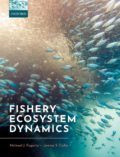
This book illuminates the deep and often underappreciated connections between basic ecology and fishery science, and explores the implications of these linkages in crafting management strategies for the 21st century.
Marine Pollution: What Everyone Needs to Know® by Judith S. WeisThis title is an overview of the issues surrounding marine pollution, including topics like its origin, marine debris, oil, and climate change.
Lastly, read the Nature article discussed in Ray Hilborn’s interview, which identifies bottom-trawling as a source of CO2 emissions, here.
Featured image: Knut Troim, CC0 via Unsplash.

Why literature must be part of the language of recovery from crisis

Wislawa Szymborska’s poem “The End and the Beginning” outlines a plan of recovery after the war: the Polish Nobel Laureate’s vision of how we return to a sense of normality is pertinent to our times, when the COVID-19 pandemic has left the world in ruins and people in an unfathomed reality. The poem, inter alia, mentions bridges—literal ones that we must cross to resume activity, but it’s not lost on the reader that bridges are also spiritual, emotional, and cultural. The bridge she constructs though, is linguistic: it rests on the pylons of ten stanzas built with the word “someone”—a person—who takes on various roles in the process of fashioning a new life. This process begins with cleaning up the destruction and ends with acknowledging the sense of wonder: “someone” must also be tasked with “gazing at the clouds”.
Szymborska, the poet, provides society with the word “fitly spoken” as in Proverbs 25: 11-12, where “A word fitly spoken is like apples of gold in a setting of silver. Like a gold ring or an ornament of gold is a wise reprover to a listening ear.” Her language incorporates, and reflects on, all aspects of human endeavors that are focused on recovery. It is this function of literature to articulate the right word at the right time, and to be that “wise reprover,” that makes the world go round, as the old saying goes.
Recovery takes many forms, the most obvious being physical, mental, and economic. But there must also be a recovery and a newly-discovered sense of values that put the human struggle in perspective and bring the world community to a strongly-held respect for life.
Recovery takes many forms, the most obvious being physical, mental, and economic. But there must also be a recovery and a newly-discovered sense of values that put the human struggle in perspective and bring the world community to a strongly-held respect for life. For many of us the COVID-19 pandemic has shaken the foundations of trust in government, has torn apart families, has left long-term physical and mental scars on individuals, and exposed the worst aspects of our character which are greed, complacency, and egoism. Yet for many others the sense of self-sacrifice and resilience have come alive, sometimes for the first time. The entire planet has been affected by this pandemic and no value has been left unturned. Literature bears testimony in deep and feeling language to our upheaval and determination to survive.
Those of us who experienced social, personal, and political duress have a story to tell that is concerned specifically with language. We understand our situation—and our human condition in uncertain times—in words. The role of language in the destruction of values as well as in their recovery cannot be overstated. Poetry records and expresses, and it keeps us alert to the spiritual consequences of our experiences. Poems and stories help us sense our place in the world and our relationship with others, they illuminate our capacity for gratitude, awe, and wonder. They provide the language to search into the mysteries of nature, and open to us surprising ways to find comfort and the strength to move beyond our personal circumstances. As Seamus Heaney’s poem “The Rainstick” wisely says, poetry teaches us to “Listen now again.”
Writers need to develop a language that seeks to illuminate the dilemmas we face today as a society. They must imagine creative forms that engage with pressing questions: what is ethical literature? What is public emotion? How does the writer create language that affects the conduct of the society? Is disaffection a tenable position in today’s world that is driven by social media and celebrity cult? The position of the writer as an outsider somehow absolved of any responsibility towards published language—meant for public consumption—is no longer viable. What are the ethical parameters under which the writer (as any researcher) probes, questions, qualifies and quantifies language and its effect on public emotion? How can literature meet culture and civilization in a meaningful way? Should the teaching of literature include a segment on practical ethics and literary language? Does thinking offer consolation? Does literature prepare us for life?
The position of the writer as an outsider somehow absolved of any responsibility towards published language—meant for public consumption—is no longer viable.
These questions are necessary in the process of re-orientation and in fashioning the narrative and the language of recovery that must include knowledge derived from other arts, social sciences, medicine, and pure science. Because the COVID-19 pandemic has affected all aspects of human health and our perspectives on life as a global community, the future must be approached with integrated thinking. Literature has a crucial role to play by offering stories that resist easy generalizations and inspire with that “word, fitly spoken”.
Among the poems that express that sense of rebirth with a newly-gained appreciation for the fragility of life, freedom, and love is Walt Whitman’s “Song of the Open Road”, which contains the thrill necessary to take the first step forward:
”Afoot and light-hearted I take to the open road,
Healthy, free, the world before me,
The long brown path before me leading wherever I choose.”
It is in this spirit of beginning a fresh journey, and having agency over that journey, that we must search the language of poetry, as we chart our future. I offer here a poem about my own sense of a new beginning.
First of MayFor Kathy
Io retornai da la santissima onda
rifatto sì come piante novelle
rinovellate di novella fronda,
puro e disposto a salire a le stelle.
–Dante, Purgatorio, Canto XXXIII 140-145
One week of furious flowering, when forsythia
burns in gardens, magnolias open like butterflies,
the ground fills with blue wild pansies, violets,
and then the winds come stealing all the petals
with their scented spells: the grass, a meadow
of rhododendron blooms early in the morning,
the edges of the garden, coloured. Spring
is passing once again, leaving chicks in nests,
us outside planting just as lilacs begin to bloom,
and summer shade of maples leafing.
I try to hold my thoughts to all these images
like I lift fresh curtains up to hang on windows,
where light will pass through, sheltering the eye
from too much sun but letting it also see outside,
where forsythia changes from yellow to green.
The Orthodox Easter Lent at the end,
praying with my children over new seeds we planted
and the robins blessed with their songs,
I emerged from the holiest waves
restored even as new trees were
renewed with new leaves,
pure and prepared to rise to the stars.*
*my translation of the Dante’s verses quoted in the epigraph
Feature image by Magnus Lunay on Unsplash

Oxford University Press's Blog
- Oxford University Press's profile
- 238 followers



